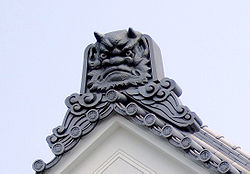
Onigawara
Encyclopedia

Japanese architecture
' originated in prehistoric times with simple pit-houses and stores that were adapted to a hunter-gatherer population. Influence from Han Dynasty China via Korea saw the introduction of more complex grain stores and ceremonial burial chambers....
. They are generally roof tiles or statues depicting a Japanese ogre (oni) or a fearsome beast. Prior to the Heian period
Heian period
The is the last division of classical Japanese history, running from 794 to 1185. The period is named after the capital city of Heian-kyō, or modern Kyōto. It is the period in Japanese history when Buddhism, Taoism and other Chinese influences were at their height...
, similar ornaments with floral and plant designs (hanagawara) preceded the onigawara. The present design is thought to have come from a previous architectural element, the oni-ta, which is a board painted with the face of an oni and was meant to stop roof leaks. During the Nara period the tile was decorated with other motives, but later it acquired distinct ogre-like features and became strongly tridimensional.DeAgostini Kodera/Butsuzō DVD series, Hōryū-ji issue's pamphlet Onigawara are most often found on Buddhist temples
Buddhist temples in Japan
Along with Shinto shrines, Buddhist temples are the most numerous, famous, and important religious buildings in Japan.The term "Shinto shrine" is used in opposition to "Buddhist temple" to mirror in English the distinction made in Japanese between Shinto and Buddhist religious structures. In...
. The tile's name notwithstanding, the ogre's face may be missing.
See also
- Shibi (roof tile)Shibi (roof tile)A is a Japanese ornamental tile set on both ends of the ridgepole that tops a shingled roof. The kanji for the word mean "kite" and "tail" respectively...
- ShachihokoShachihokoA is an animal in Japanese folklore with the head of a tiger and the body of a carp. It was believed that this animal could cause the rain to fall, and as such, temples and castles were often adorned with roof ornaments crafted in the form of a shachihoko, in order to protect them from fire.The...
- GargoyleGargoyleIn architecture, a gargoyle is a carved stone grotesque, usually made of granite, with a spout designed to convey water from a roof and away from the side of a building thereby preventing rainwater from running down masonry walls and eroding the mortar between...
- Chimera (architecture)Chimera (architecture)Used in describing an architectural feature, chimera means a fantastic, mythical or grotesque figure used for decorative purposes. Chimerae are often described as gargoyles. Used correctly, the term gargoyle refers to mostly eerie figures carved specifically as terminations to spouts which convey...
- Imperial roof decorationImperial roof decorationChinese imperial roof decoration or roof charms or roof-figures or or was only allowed on official buildings of the empire. Chinese roofs are typically of the hip roof type, with small gables...
- Japanese architectureJapanese architecture' originated in prehistoric times with simple pit-houses and stores that were adapted to a hunter-gatherer population. Influence from Han Dynasty China via Korea saw the introduction of more complex grain stores and ceremonial burial chambers....

